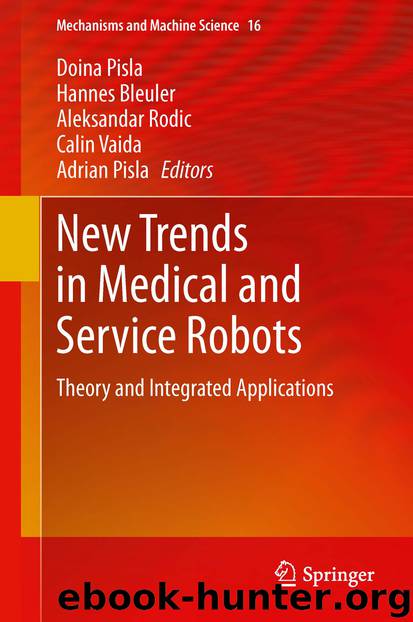New Trends in Medical and Service Robots by Doina Pisla Hannes Bleuler Aleksandar Rodic Calin Vaida & Adrian Pisla

Author:Doina Pisla, Hannes Bleuler, Aleksandar Rodic, Calin Vaida & Adrian Pisla
Language: eng
Format: epub
Publisher: Springer International Publishing, Cham
4.2 Control Equipment and Software Engineering
The considerations about control equipment and software engineering have led to the following topology of the control system: each actuator is connected to a drive amplifier individually, and the drive amplifiers are connected to the robot control. The decision to host the robot control on a micro-controller reduces the occupied design space to the footprint of as small as a credit card, while maintaining favorable properties of real-time reactivity. The robot control software on the microcontroller features all functionalities that are required to start up, to operate and, most important, to maintain the safety of the robot. This provides that the robot control and the drive amplifiers form a self-contained subsystem.
There is a robot programming interface the microcontroller offers to superordinated operators, in order to exchange robot programming commands. There are multiple realizations of such an operator, for example, an interpreter of a robot language, or an user interface that transmits the operator’s commands. The fact that the robot control is self-contained provides the argument that the robot programming interface is not necessarily subject to real-time constraints. In consequence, candidate bus systems for this programming interface do not have to provide this property themselves. This includes interfaces with partially non-deterministic transmission times in further considerations. The underlying case study proposes USB and TCP/IP for this purpose. This is also a result of the proposal to host the software part of the operator on a desktop PC. In the future, this technology is ready for implementation of wireless communication channels. This enhancement is a piece of infrastructure to integrate mobile devices into the programming workflow of the human operator. In such a scenario, the human operator would work with a tablet computer to interact with multiple of such lab automation cells with the very same device. This idea reduces the hardware costs and also the required lab space further.
A generic software architecture for robot control software on microcontrollers is proposed, see (Dietrich et al. 2012) for more details. In brief, the idea is to provide an object-oriented hierarchy of abstract base classes that resembles the typical system topology of a lab automation robot. Figure 7 shows a realization of this idea in the case study, where the top-level object (FiveBar_Z) is an achievement of the abstract base class (Roboter). This class aggregates actuator objects in general, which is specialized as CiA402 profiles and proprietary drive profiles in the case study. These actuator objects access communication objects that synchronize data between the microcontroller and the particular drive amplifier. Their communication is taken over by implementations of CANopen and RS485 protocol stacks via respective bus controllers.
Fig. 7Component view on robot control architecture
Download
This site does not store any files on its server. We only index and link to content provided by other sites. Please contact the content providers to delete copyright contents if any and email us, we'll remove relevant links or contents immediately.
Algorithms of the Intelligent Web by Haralambos Marmanis;Dmitry Babenko(8523)
Test-Driven Development with Java by Alan Mellor(7428)
Data Augmentation with Python by Duc Haba(7318)
Principles of Data Fabric by Sonia Mezzetta(7065)
Learn Blender Simulations the Right Way by Stephen Pearson(7007)
Microservices with Spring Boot 3 and Spring Cloud by Magnus Larsson(6825)
RPA Solution Architect's Handbook by Sachin Sahgal(6236)
Hadoop in Practice by Alex Holmes(6032)
The Infinite Retina by Robert Scoble Irena Cronin(5937)
Jquery UI in Action : Master the concepts Of Jquery UI: A Step By Step Approach by ANMOL GOYAL(5873)
Big Data Analysis with Python by Ivan Marin(5732)
Life 3.0: Being Human in the Age of Artificial Intelligence by Tegmark Max(5405)
Pretrain Vision and Large Language Models in Python by Emily Webber(4693)
Infrastructure as Code for Beginners by Russ McKendrick(4472)
WordPress Plugin Development Cookbook by Yannick Lefebvre(4205)
Functional Programming in JavaScript by Mantyla Dan(4124)
The Age of Surveillance Capitalism by Shoshana Zuboff(4118)
Embracing Microservices Design by Ovais Mehboob Ahmed Khan Nabil Siddiqui and Timothy Oleson(3996)
Applied Machine Learning for Healthcare and Life Sciences Using AWS by Ujjwal Ratan(3972)
